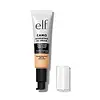What's inside
What's inside
 Key Ingredients
Key Ingredients

 Benefits
Benefits

 Concerns
Concerns

 Ingredients Side-by-side
Ingredients Side-by-side

Zinc Oxide 6.3%
Cosmetic ColorantTitanium Dioxide 6%
Cosmetic ColorantHomosalate 5%
Skin ConditioningEthylhexyl Salicylate 4.5%
UV AbsorberOctocrylene 3%
UV AbsorberWater
Skin ConditioningDimethicone
EmollientButylene Glycol
HumectantCetyl PEG/PPG-10/1 Dimethicone
EmulsifyingButyloctyl Salicylate
Skin ConditioningButylene Glycol Dicaprylate/Dicaprate
EmollientPanthenol
Skin ConditioningSynthetic Fluorphlogopite
Polyglyceryl-4 Isostearate
EmulsifyingMagnesium Sulfate
Acrylates/Polytrimethylsiloxymethacrylate Copolymer
Skin ConditioningTrehalose
HumectantPhenoxyethanol
PreservativeHydrated Silica
AbrasiveDisteardimonium Hectorite
StabilisingTriethoxycaprylylsilane
Hydrogen Dimethicone
Aluminum Hydroxide
EmollientTriethyl Citrate
MaskingEthylhexylglycerin
Skin ConditioningCaprylyl Glycol
EmollientDisodium EDTA
Tin Oxide
AbrasiveTocopheryl Acetate
AntioxidantTremella Fuciformis Extract
HumectantSodium Hyaluronate
HumectantNiacinamide
SmoothingAscorbyl Palmitate
AntioxidantCanola Oil
EmollientGlycerin
HumectantDaucus Carota Sativa Seed Oil
Emollient1,2-Hexanediol
Skin ConditioningDaucus Carota Sativa Root Extract
Skin ConditioningHelianthus Annuus Seed Oil
EmollientBeta-Carotene
Skin ConditioningSoluble Collagen
HumectantCI 77891
Cosmetic ColorantCI 77492
Cosmetic ColorantCI 77491
Cosmetic ColorantCI 77499
Cosmetic ColorantZinc Oxide 6.3%, Titanium Dioxide 6%, Homosalate 5%, Ethylhexyl Salicylate 4.5%, Octocrylene 3%, Water, Dimethicone, Butylene Glycol, Cetyl PEG/PPG-10/1 Dimethicone, Butyloctyl Salicylate, Butylene Glycol Dicaprylate/Dicaprate, Panthenol, Synthetic Fluorphlogopite, Polyglyceryl-4 Isostearate, Magnesium Sulfate, Acrylates/Polytrimethylsiloxymethacrylate Copolymer, Trehalose, Phenoxyethanol, Hydrated Silica, Disteardimonium Hectorite, Triethoxycaprylylsilane, Hydrogen Dimethicone, Aluminum Hydroxide, Triethyl Citrate, Ethylhexylglycerin, Caprylyl Glycol, Disodium EDTA, Tin Oxide, Tocopheryl Acetate, Tremella Fuciformis Extract, Sodium Hyaluronate, Niacinamide, Ascorbyl Palmitate, Canola Oil, Glycerin, Daucus Carota Sativa Seed Oil, 1,2-Hexanediol, Daucus Carota Sativa Root Extract, Helianthus Annuus Seed Oil, Beta-Carotene, Soluble Collagen, CI 77891, CI 77492, CI 77491, CI 77499
Water
Skin ConditioningSqualane
EmollientPolyglyceryl-3 Diisostearate
EmulsifyingMethyl Dihydroabietate
Mica
Cosmetic ColorantDisteardimonium Hectorite
StabilisingPropanediol
SolventGlycerin
HumectantIsostearic Acid
CleansingPolyglyceryl-10 Pentaisostearate
EmollientSilica
AbrasiveSodium Chloride
MaskingCocos Nucifera Water
MaskingJojoba Esters
EmollientCocos Nucifera Fruit Juice
EmollientBoron Nitride
AbsorbentSodium Hyaluronate
HumectantTocopherol
AntioxidantAscorbic Acid
AntioxidantBisabolol
MaskingTocopheryl Acetate
AntioxidantEthylhexylglycerin
Skin ConditioningPhenoxyethanol
PreservativeBenzyl Benzoate
AntimicrobialAroma
CI 77891
Cosmetic ColorantIron Oxides
Water, Squalane, Polyglyceryl-3 Diisostearate, Methyl Dihydroabietate, Mica, Disteardimonium Hectorite, Propanediol, Glycerin, Isostearic Acid, Polyglyceryl-10 Pentaisostearate, Silica, Sodium Chloride, Cocos Nucifera Water, Jojoba Esters, Cocos Nucifera Fruit Juice, Boron Nitride, Sodium Hyaluronate, Tocopherol, Ascorbic Acid, Bisabolol, Tocopheryl Acetate, Ethylhexylglycerin, Phenoxyethanol, Benzyl Benzoate, Aroma, CI 77891, Iron Oxides
 Reviews
Reviews

Ingredients Explained
These ingredients are found in both products.
Ingredients higher up in an ingredient list are typically present in a larger amount.
Ci 77891 is a white pigment from Titanium dioxide. It is naturally found in minerals such as rutile and ilmenite.
It's main function is to add a white color to cosmetics. It can also be mixed with other colors to create different shades.
Ci 77891 is commonly found in sunscreens due to its ability to block UV rays.
Learn more about CI 77891Disteardimonium Hectorite comes from the clay mineral named hectorite. It is used to add thickness to a product.
It can also help stabilize a product by helping to disperse other ingredients.
Hectorite is a rare, white clay mineral.
Learn more about Disteardimonium HectoriteEthylhexylglycerin (we can't pronounce this either) is commonly used as a preservative and skin softener. It is derived from glyceryl.
You might see Ethylhexylglycerin often paired with other preservatives such as phenoxyethanol. Ethylhexylglycerin has been found to increase the effectiveness of these other preservatives.
Glycerin is already naturally found in your skin. It helps moisturize and protect your skin.
A study from 2016 found glycerin to be more effective as a humectant than AHAs and hyaluronic acid.
As a humectant, it helps the skin stay hydrated by pulling moisture to your skin. The low molecular weight of glycerin allows it to pull moisture into the deeper layers of your skin.
Hydrated skin improves your skin barrier; Your skin barrier helps protect against irritants and bacteria.
Glycerin has also been found to have antimicrobial and antiviral properties. Due to these properties, glycerin is often used in wound and burn treatments.
In cosmetics, glycerin is usually derived from plants such as soybean or palm. However, it can also be sourced from animals, such as tallow or animal fat.
This ingredient is organic, colorless, odorless, and non-toxic.
Glycerin is the name for this ingredient in American English. British English uses Glycerol/Glycerine.
Learn more about GlycerinPhenoxyethanol is a preservative that has germicide, antimicrobial, and aromatic properties. Studies show that phenoxyethanol can prevent microbial growth. By itself, it has a scent that is similar to that of a rose.
It's often used in formulations along with Caprylyl Glycol to preserve the shelf life of products.
Sodium Hyaluronate is hyaluronic acid's salt form. It is commonly derived from the sodium salt of hyaluronic acid.
Like hyaluronic acid, it is great at holding water and acts as a humectant. This makes it a great skin hydrating ingredient.
Sodium Hyaluronate is naturally occurring in our bodies and is mostly found in eye fluid and joints.
These are some other common types of Hyaluronic Acid:
Learn more about Sodium HyaluronateTocopheryl Acetate is AKA Vitamin E. It is an antioxidant and protects your skin from free radicals. Free radicals damage the skin by breaking down collagen.
One study found using Tocopheryl Acetate with Vitamin C decreased the number of sunburned cells.
Tocopheryl Acetate is commonly found in both skincare and dietary supplements.
Learn more about Tocopheryl AcetateWater. It's the most common cosmetic ingredient of all. You'll usually see it at the top of ingredient lists, meaning that it makes up the largest part of the product.
So why is it so popular? Water most often acts as a solvent - this means that it helps dissolve other ingredients into the formulation.
You'll also recognize water as that liquid we all need to stay alive. If you see this, drink a glass of water. Stay hydrated!
Learn more about Water